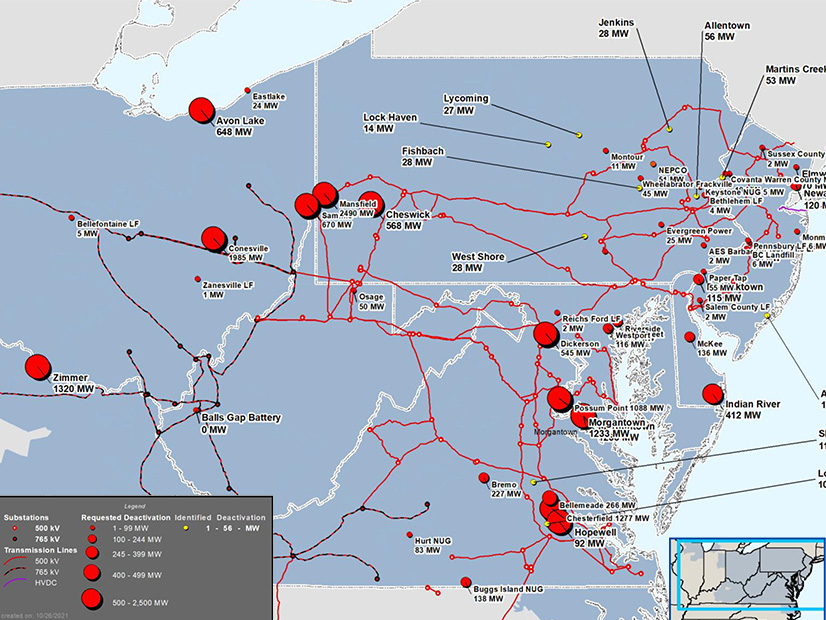Planning Committee
Winter Weekly Reserve Target Endorsed
PJM stakeholders unanimously endorsed the results of the 2021/22 winter weekly reserve target analysis at Tuesday’s Planning Committee meeting.
Patricio Rocha Garrido, of PJM’s resource adequacy planning department, reviewed the results of the analysis, saying the numbers differed slightly from 2020/21 because of more uncertainty in the modeling. Rocha Garrido first presented the analysis numbers at last month’s PC and Operating Committee meetings. (See “Winter Weekly Reserve Target Update,” PJM Operating Committee Briefs: Oct. 7, 2021.)
Members also unanimously endorsed the analysis at Thursday’s OC meeting.
The targets for December, January and February are 24%, 27% and 21% respectively, compared to 23%, 27% and 23% last year. Rocha Garrido said the December value increased slightly because PJM sees more load uncertainty in the modeling, while February’s decrease is a result of less load uncertainty.
PJM staff use the targets, which are part of the reserve requirement study, to help coordinate planned generator maintenance scheduling over the winter months. Rocha Garrido said the purpose of the targets is to “cover against uncertainties” related to load and forced outages, ensuring that the loss-of-load expectation (LOLE) for winter is “practically at zero.”
The winter weekly reserve target for each month is the highest weekly reserve percentage, rounded up to the next integer value. Rocha Garrido said the targets are only recommendations to PJM’s operations department.
Manual Endorsements
Several manual updates stemming from the biennial cover-to-cover review also won unanimous stakeholder endorsement. The updates were first presented at the October PC meeting. (See “Manual First Reads,” PJM PC/TEAC Briefs: Oct. 5, 2021.)
Michael Herman, of PJM’s transmission planning department, provided a review of Manual 14B: PJM Region Transmission Planning Process Update, including the addition of a new section that features details around the incorporation of end-of-life (EOL) needs in the Regional Transmission Expansion Plan, which were part of the tariff attachment M-3 discussions.
FERC in December rejected a stakeholder proposal to move EOL projects under PJM’s planning authority, siding with transmission owners who argued that it would violate their rights. (See FERC Rejects PJM Stakeholder EOL Proposal.) The commission also accepted the TO sector’s tariff amendments concerning EOL projects in August 2020, rejecting arguments in rehearing requests by more than a dozen load-side stakeholders. (See FERC Accepts PJM TOs’ End-of-life Revisions.)
John Reynolds, of PJM’s resource adequacy planning department, reviewed minor changes to Manual 19: Load Forecasting and Analysis. Reynolds said the most significant change was adding battery storage to the list of forecasted items in the load forecast model overview in Section 3.1, which already includes distributed solar generation, plug-in electric vehicles and historical weather patterns to estimate growth in peak load and energy use.
Joseph Hay, of PJM’s infrastructure coordination department, reviewed the updates to Manual 14F: Competitive Planning Process, saying the changes were necessary to correct the proposal fee structure in the manual to conform to the Operating Agreement.
Hay said the language in Manual 14F was not in agreement with the latest changes to the OA, which states, “All proposals in any RTEP window are subject to a nonrefundable deposit of $5,000, except for project proposals submitted with cost estimates of $5 million or less. In addition to the $5,000 nonrefundable deposit, the proposing entity must pay all actual costs incurred by PJM to evaluate the submitted project proposal.”
The manual changes now go to the Nov. 17 Markets and Reliability Committee meeting for endorsement.
Transmission Expansion Advisory Committee
Generation Deactivation Notification
Phil Yum of PJM provided an update on recent generation deactivation notifications.
PJM has received a “good amount” of deactivation requests in the last month in the PPL transmission zone, he said. Those requests include:
- Williamsport CT 1 and 2 oil-fired units, with a total of 26.6 MW of generation;
- West Shore CT 1 and 2 oil-fired units, 28 MW;
- Lock Haven CT 1 oil-fired unit, 14 MW;
- Jenkins CT 1 and 2 oil-fired units, 27.6 MW; and
- Fishbach CT 1 and 2 oil-fired units, 28 MW.
The requested deactivation date for these units is April 1, 2022.
Several other units in the PPL transmission zone have a requested deactivation date of June 1, 2022. Those units include:
- Martins Creek CT 1, 2 and 3 oil-fired units, 57.3 MW;
- Harrisburg CT 1, 2 and 3 oil-fired units, 41.1 MW; and
- Allentown CT 1, 2, 3 and 4 oil-fired units, 56 MW.
Four different units in the Dominion transmission zone were also added to the deactivation list, with a requested date of June 1, 2023. They include:
- Rockville CT diesel unit, 4 MW;
- Lanier CT 1 diesel unit, 7 MW;
- Dinwiddie CT 1 diesel unit, 3 MW; and
- Weakley CT diesel unit, 7 MW.
A reliability analysis was completed for all units, and no violations were identified.



